In an effort to achieve standardization objectives for purchases of products used by the military and other government organizations, the U.S. Department of Defense created standards that these products must meet. You will see these standards called military standard, “MIL-STD”, or “MIL-SPEC.” These standards ensure products meet certain requirements, commonality, reliability, compatibility, and similar defense-related objectives.
The Department of Defense also has standards for two-way radios and radios that meet this standard must meet levels for such criteria as vibration, rain, salt air, sand/dust, shock (dropping), humidity, temperature as well as other factors.
Buying two way radios that meets mil-spec standards means you are buying a quality product that is built to withstand tougher use.
You may also see radios with an “IP” designation. IP stands for Ingress Protection and it is an international standard that specifies the sealing effectiveness of the enclosure of a product. It is a two digit code that tell you how effective the enclosure is to penetration from fingers, dust, and moisture.
For instance, for a radio that meets IP 55, the first 5 means it is protected from the amount of dust that would interfere with its operation. The second 5 means that it is protected from water that shoots from a nozzle.
So when it comes time to purchase a two way radio you need to ask yourself what kind of usage it’s going to see. In industrial environments or for heavy-duty outdoor usage, you likely need a mil spec radio. In an office environment or for residential use you could probably get away with a lighter duty radio as long as you don’t drop it too often.
Most Mil-Spec radios will also have some feature content you will probably not find on lower cost radios. Channel Scanning is one such feature. If you want to monitor more that one channel, then you’ll need channel scanning capability. Higher quality accessories such as headsets with strain reliefs are another. Features like emergency call (man down), plus two-tone encode and DTMF tones that can activate other systems are additional features not found on cheap two way radios.
For more assistance on choosing the right radio for you, make sure you get the free book called Two-Way Radio Success: How to Choose Two-Way Radios, Commercial Intercoms, and Other Wireless Communication Devices For Your Business.
